Assessment |
Biopsychology |
Comparative |
Cognitive |
Developmental |
Language |
Individual differences |
Personality |
Philosophy |
Social |
Methods |
Statistics |
Clinical |
Educational |
Industrial |
Professional items |
World psychology |
Language: Linguistics · Semiotics · Speech
Hand gestures, are gestures performed by one or two hands. For movements involving the rest of the body, see gesture. Some hand gestures are closely tight to speech, some are like word themselves. The gestures listed below of such kind, they are so-called emblems, or emblematic gestures (Ekman & Friesen, 1972) or quotable gestures (Kendon 2004). These gestures are conventionalized and culture specific. This means that this type of gestures have a fixed meaning that can be verbalized in a couple of words within one culture. The same hand shape may mean something different in another culture. There are not only culture specific emblems, even within a culture there are gestures that are specific to a sub-community of the population. Hence, the gestures that can be found below may mean something specific within a small group of people.
Using one hand[]
Approximation[]
The "approximation" gesture is performed by holding the hand horizontally, palm down, with the fingers forward or spread, and then tilting the hand to the left and to the right. It indicates that a number or a statement is to be taken approximatively.
Likewise, the gesture, with a gentle rocking left-right movement, is understood to mean "so-so", (or, not too good, not too bad) a response one might give to the question, "How's it going with you?"
This response-gesture is equivalently understood among various cultures or language groups; in particular the Spanish, French, and other romance language groups use it.
Aún Hay Más (There's Still More)[]
In Mexico, television presenter Raul Velasco prominently used in his program Siempre en Domingo (Always on Sunday) a hand gesture that is commonly used by floor directors of television programs in North America as to indicate to presenters the need for a commercial break. The gesture implies using the thumb and index finger as to represent a letter "C". Usually, the gesture occurs elsewhere behind cameras, but Velasco used it in front of them, and most often saying "Aún hay más" (There's still more to come) while using the gesture. As an indirect result, Mexicans adopted the gesture in common cultural use as to signal the need to interrupt whatever the speaker is doing and request a break from a listener. The gesture's use is widespread in Mexico, and is used to a lesser extent in the rest of Latin America, due to "Siempre en Domingo"'s widespread popularity across the continent.
Bang bang or Pistols[]
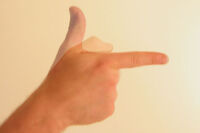
This gesture mimes a handgun.
The "bang bang" gesture is performed by raising the fist with the index finger and thumb extended. The index finger points at the recipient. The thumb is then brought down on top of the fingers. This imitation of the action of a revolver pistol is often meant to represent a handgun in children's games. It may also be used menacingly to mean "I'm gonna kill you", or simply as a playful greeting. The middle finger is often also extended to widen the "barrel".
Texas Tech fans use a similar salute known as "guns up" to cheer for their sports teams. Also, the "bang bang" performed with both hands was a signature gesture of professional wrestler Mick Foley while he was in his "Cactus Jack" persona. This gesture was also used in the movie Happy Gilmore as Shooter McGavin's trademark.
Also, if the thumb and middle finger are used to click, and if the thumb is pointed upwards to form the gun, this can also be interpreted as a greeting.
Pointing at ones own temple and "firing" with the thumb signifies acknowledgment of ones own guilt or error. For example, a motor vehicle driver who had carelessly endangered another might perform this gesture in response to a honking or shaken fist by the offended party. This use of the gesture may even be used to silently represent an unpleasant situation, as when an annoying person walks into the room.
Beckoning sign[]
Index finger sticking out of the clenched fist, palm facing the gesturer. The finger moves repeatedly towards the gesturer (in a hook) as to draw something nearer. It has the general meaning of "come here", although it is normally seen as condescending or anyway impolite. It is sometimes performed with the four fingers, with the entire hand, or even with the arm, depending on how far the recipient of the sign is.
When performed with the index finger, it may have a mild sexual connotation depending on the circumstance.
In Africa, this sign is given with all four fingers and with the palm down.
In Japan there is a similar gesture, but the four fingers are used, the palm faces the recipient and the hand is at head's height. This is the gesture featured in the maneki neko. Performed in the western manner, it is still beckoning, but is extremely rude.
In China, the palm faces downward, and all four fingers gesture inward two or three times, as a friendly request for the target to come toward the signer. The same gesture, with the arm extended outward and to the side, is also used in China to hail a taxi.
In India, it is performed with the palm down and the hand slightly loose, almost jerking.
Benediction and blessing[]
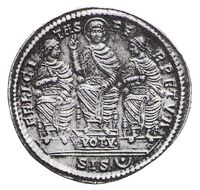
Benediction gesture, on a coin of Emperor Constantine.
The benediction gesture is a raised right hand with the ring and little fingers touching the palm, while the middle and index fingers remain raised. Taken from Ancient Roman icongraphy for speaking (an example is the Augustus of Prima Porta where the emperor Augustus assumes the pose of an orator in addressing his troops), it is used as a simple charm or blessing amongst many modern Pagans, and has a vast array of uses.
A similar sign, called the benediction gesture, is used by the Christian clergy to perform blessings with the sign of the cross; however Christians keep the thumb raised - the three raised fingers (index, middle, and thumb) are frequently allegorically interpreted as representing the three Persons of the Holy Trinity. It was shown by representations of Jesus as Christ Pantocrator.
Biting one's thumb[]
In the Shakespeare play Romeo and Juliet, Capulet's servant Sampson precipitates a brawl by biting his thumb at Montague's servant Abraham. In the scene it appears that biting one's thumb in Verona is a non-verbal equivalent of fighting words, probably similar to the middle finger gesture. Sampson explains the meaning of the gesture to his companion Gregory, indicating that the gesture would have been unfamiliar even to the original audience of the play. The play does not describe the gesture in detail, but in performances of the play it is often enacted by placing the thumb upright (as in a "thumbs up" sign) just behind the upper inscisors , then flicking the thumb outward in the direction of person the gesture is meant to insult.
Blah-blah[]
The fingers are kept straight and together in a horizontal fashion while the thumb is held out straight. The fingers and thumb then snap together repeatedly to suggest a mouth talking. It is used to indicate contempt for a person talking for an excessive period of time about nothing the gesturer feels is important.
In Singapore and Malaysia, however, the "blah-blah" hand-gesture of what appears to be a talking hand is used to represent the number 5 or a 5 with any number of zeroes trailing it. As such, the "opening-and-closing" blah-blah hand-gesture can represent a five, fifty, five-hundred, five-thousand, etc, etc.
Cheque, please[]
This gesture, understood by waiters around the world to mean that a dinner patron wishes to pay the bill and depart, is executed by touching the index finger and thumb together and "writing" a wavy line in the air, as if to sign one's name. An alternate gesture with the same meaning is made by touching the index finger and thumb together and drawing a checkmark (✓) in the air. In Egypt, the left hand is held palm-out and the right, palm-down, is tapped against the left wrist to request the check. In Thailand, Singapore, and Malaysia, one makes a circling gesture with the thumb and fingers pinched together- as if you are holding an imaginary pencil and making imaginary scribbles on a piece of paper. Sometimes the opposite palm is used as the 'paper'. In the Philippines, one outlines a rectangle in the air using the thumb and forefinger of both hands.
Clenched fist[]
A raised, clenched fist is used as a gesture of defiance by a number of groups. It is usually considered to be hostile, yet without any sexual, scatological, or notionally offensive connotations. It is especially associated with Communists with other nationalist or ethnic revolutionary or would-be revolutionary movements, and with the Black Power movements of the 1960s in the United States. It is the custom to make this gesture while singing The Internationale, the Marxist anthem. A clenched fist raised quickly up and down and then punched in some direction also signifies a military call for a heavy weapons team to close on the gesturer or to move or open fire in the direction indicated by the punch. This gesture can also be used to mean "I am angered or offended by what you have done."
- See also: With a strong hand and an outstretched arm
Clinton thumb[]
The gesture dubbed the "Clinton thumb" after its most famous user, Bill Clinton, is used by politicians to provide emphasis in speeches without pointing the finger. This gesture has the thumb leaning against the thumbside portion of the index finger, which is part of a closed fist. It does not exhibit the anger of the clenched fist or pointing finger, and so is thought to be less threatening. This gesture was likely adopted by Clinton from John F. Kennedy, who can be seen using it in many speeches during his political career.[How to reference and link to summary or text]
Crossed fingers[]
A gesture made by crossing the index and middle fingers such that the middle finger overlaps and intertwines the index finger, which can be used to signify one's hope that something should succeed (compare to the phrase "Keep your fingers crossed."). According to OldSuperstitions.com, this stems from the superstition that "By making the sign of the Christian faith with our fingers, evil spirits would be prevented from destroying our chances of good fortune." Thus it would be one of several uses of the "sign of the Cross" in connection with a prayer for blessing. However, if placed behind one's back, the gesture takes on an entirely different meaning: it is then normally used to indicate that the user secretly (hence the hiding of the gesture) wishes for something contrary to what is being stated or going on, or that a lie is being told. This terms, may be related to the making of the sign of the cross when taking an oath (in this case a secret one).
Cuckoo sign[]
A gesture made by closing one's fist, extending the index finger, and circling it around ones ear or temple for several seconds. This gesture is used to indicate that someone is speaking nonsense or is crazy (more colloquially, this is described as being cuckoo). The "cuckoo" sign is well-known in the United States.
Curwen Hand Signs[]
- See also: Kodály Method
Named after John Curwen, and largely defined by Zoltán Kodály, The Curwen Hand Signs are a way of representing musical notes by holding the hand in a certain position for each note.
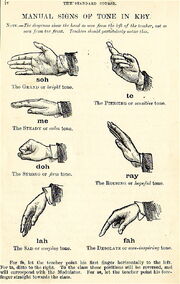
Depiction of Curwen's Solfege hand signs. This version includes the tonal tendencies and interesting titles for each tone.
The basic concept of using gestures to represent notes is quite ancient, however near the end of the 19th century, the concept was formalized as a standard teaching method. (External link, with sample pictures: [2])
The Fangul[]
This is done by keeping one hand straight, placing it under the chin, and 'throwing out' that hand toward the receiver of the gesture.
"Fangul" is not an Italian word, but its probable origins are in the Italian word "Vaffanculo", which means "Go fuck yourself".
In Italian culture this gesture means "Chi se ne frega?" or "Who cares?". If done with less intensity, it can also simply mean "No" or "None", as, for example, in response to "Do we have any milk at home?".
In Italian-American culture, on the other hand, the gesture means "Screw You!". There is a subtle difference between the offensive version of the gesture and the innocuous version. In the "Screw You" version, the fingers are kept stiff and together and the motion is quick and abrupt. In the less offensive "I don't care" version, which has its root in Europe, the fingers fan out and the motion is gentle/nonchalant.
U.S. Supreme Court justice Antonin Scalia received criticism for using this gesture towards a reporter. (Scalia maintains that he intended the less offensive Sicilian gesture, which means "I don't care".) When comedian Stephen Colbert performed at the 2006 White House Correspondents' Dinner, he flashed the gesture at Scalia, saying that he was pleased to see him there.
In the Indian sub-continent, scratching under the chin would signify that one is trying to think.
Fig sign[]

The "fig sign" is an ancient gesture with many uses.
The "fig sign" is a gesture made with the hand and fingers curled and the thumb thrust between the middle and index fingers, or, rarely, the middle and ring fingers, forming the fist so that the thumb partly pokes out. In some areas of the world, the gesture is considered a good luck charm, in others it is considered an obscene gesture, and in still others it is used in the "I've got your nose!" child's game. This gesture is also the letter "T" in the American Sign Language alphabet. In International Sign, which otherwise uses the same manual alphabet, "T" has been modified to avoid possible offense.
In ancient Rome, this gesture was called the mano fico, and was a fertility and good luck charm designed to ward off evil. Although this usage has survived in Latin America, where carved images of hands in this gesture are used in good luck talismans, in many other cultures, such as Indonesia, Turkey and Russia, the sign has come to have an insulting meaning roughly equivalent to "screw you", based on the thumb being seen as representing a clitoris or sexual intercourse; this usage goes back at least 600 years, being attested in The Divine Comedy (Inferno, Canto XXV). In modern Russia this gesture is used mostly by kids with the meaning "screw you/no way". The same meaning is expressed by adults either with the bent elbow (rude, very emphatic, non-classy), or with the "finger" (used mostly by city dwellers). The "finger" made it to Russian gesture language from Western movies. In modern Italian, the gesture is called the mano fica, taken to mean "fig hand", as the Italian word for "fig" is fico (ficus in Latin). The obscene connotations of the gesture may partly originate from the fact that a similar Italian word, fica, is a slang term referring to the vulva. This sexual connotation may date back to ancient Roman times; some Roman amulets combine a phallus and a mano fico gesture. In the Indian sub-continent, this gesture is taken as threatening symbol.
The gesture is also used in a trick played by adults and parents, with the intention of convincing their child that his or her nose has been ripped off. Someone, usually an adult, grabs at the child's nose and forms the fig sign, exclaiming, "I've got your nose, I've got your nose!" The thumb is supposed to be the child's removed nose.
Many neopagans use this gesture as a symbol of the mother goddess to help adherents identify one another. In this context, it is referred to as the "Sign of the Goddess". Its counterpart is the corna sign.
Finger Beside Nose[]
This gesture involves bringing the index finger to the side of the nose and is used in the USA and the UK to indicate that something secret is being told. It is often accompanied by a conspiratorial wink. Placing the finger beside the nose is often used by storytellers to signal that they are stretching the truth. As a variant, sometimes the finger is tapped next to the nose.
Clement Moore's version of the Santa Claus story first used the now familiar phrase, "...laying his finger aside of his nose...," in which Santa, upon discovery, made this gesture and winked before vanishing up the chimney. Another interesting reference from the Urdu poem "The Fourth Era of Āb-e ḥayāt:Part Three" is as follows: "When the Navab's gaze fell on him, he placed a finger beside his nose [as women do] and recited"...
Finger Snap[]
A single snap, sometimes emphasised by an arced swing of the arm, is used when someone is reminded of something by another person, particularly if it is a job or a chore they have forgotten to do.
Some people also snap their fingers to catch the attention of others. This is informal - some people may find it rude or even threatening, as it is common for the gesturer to snap his fingers very close to the other's face. In some cases, this may be interpreted as a face-threatening act or a sign of contempt.
In a classroom, children may snap their fingers to indicate that they are eager to give the answer to a question.
It can also be used when telling a story, to get a surprise effect.
In Latin America this gesture is used as a way to say "Hurry up"
The Beats used to snap repeatedly as more reserved "cooler" applause.
Fours snaps in the shape of the letter Z are used to convey superiority or disdain for all others. This is called a "Z snap".
Gig 'em Aggies[]
- Main article: Gig 'em Aggies

Gig 'em sign
Current and former students of Texas A&M University, as well as supporters of the school's athletic teams, widely use a thumbs-up sign associated with the cheer "Gig 'em Aggies" (or simply "Gig 'em"). The thumb refers to a "gig" used for hunting frogs. It was created around 1930. While its creation is universally credited to Pinky Downs, a 1906 A&M graduate who was then a member of the school's Board of Regents, stories of its origin vary. The most commonly cited story revolves around one of A&M's major rivals at that time, the TCU Horned Frogs (although the "frog" of TCU is actually a Texas horned lizard). It was the first hand sign to be used in the former Southwest Conference, the athletic conference that A&M, TCU, and Texas all belonged to at the time.
Fans of opposing teams may turn the gesture against the Aggies by turning the thumb down, or turning it into a throat-slitting gesture.
Hook 'em Horns[]
- Main article: Hook 'em Horns
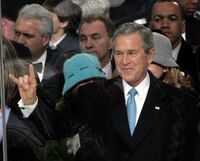
George W. Bush gives the Hook 'em Horns salute to the Texas Longhorns marching band at his second inauguration.
In college sports in the United States, the "Hook 'em Horns" (or simply "Hook 'em") sign is associated with fans of the Texas Longhorns. The gesture is an imitation of the head of a Texas Longhorn, which serves as the school mascot. It was created in 1955 by a UT cheerleader in response to the increasingly popular "Gig'Em" hand signal created by arch rival Texas A&M twenty five years earlier. It is one of the most famous hand symbols in US college sports.
Students, faculty, and alumni of the University of Texas are often seen to display this hand sign during sporting events, commencements, and other special occasions. They will often include the spoken or written phrase in conversations or writings, especially as a closing. The Hook 'em Horns symbol is the same physically as the mano cornuto gesture. They both have their origins in the imitation of a type of livestock, the longhorn on one hand and a goat on the other, though their meanings are very different. (Pease, A et al., 2004, The Definitive Book of Body Language).
If the symbol is displayed fingers downward it is considered to be an insult to Longhorn fans (often displayed by Longhorn opponents, literally "They're going down", colloquially used to imply defeat).
In Major League Baseball, defensive players often use an identical gesture to each other to indicate the opposing team has two outs. The same gesture is used in American football to indicate a team faces second down. This gesture may be popular for indicating the number 2 because the fingers are further apart - making it easier to see that two (as opposed to one) fingers are raised when viewed from a distance.
Horns[]
- Main article: Corna
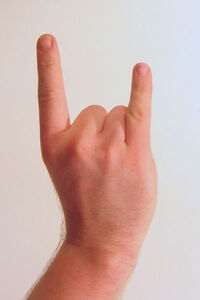
Corna
Many neopagans use it as a symbol of the horned god to identify each other; in this context it is referred to as the "Sign of the Horned God". Its counterpart is the fig sign, above. Also considered similar to the Horns of Asmodeus, from Persian mythology, used to warn off the devil.
Some say that it is meant to ward off — or to bestow — the evil eye. It is also a representation of the Devil by some Satanists. The gesture's origin is believed to be an imitation of the shape of a goats head, which has many associations with the concept of Satan in Christianity Satan's Goat
It has a variety of other meanings as well, depending on culture and area. In some places, it is a sexual insult, charging a man with being a victim of cuckoldry (this insult is most common in Italy and is also used in Portugal and Brazil). Perhaps because of its occult significance, it is used as a salute by fans of heavy metal music. This use may have originated with Ronnie James Dio or KISS. The sign may have been used in P-Funk music before heavy metal. If one reverses the extended fingers, one gets the "inverted heavy metal salute" which can be given as a reply to a heavy metal salute.
How Sad[]
How Sad is a mockery act by rubbing the thumb and index finger together when someone is telling you a sad story that really isn't that sad. This is also called Playing the World's Smallest Violin.
I Love You Sign[]
Made using a combination of the letters 'I', 'L', and 'Y' from American Sign Language. It is made by extending the thumb, index finger, and little finger while the middle and ring finger touch the palm.
Knocking on wood[]
- Main article: touch wood
This signifies the neutralization of a jinxing brought on by mentioning an either hoped-for or feared result. The knuckles are rapped on a nearby piece of wood (or, jokingly, someone's head). Usually this is only valid if done on bare (i.e. unpainted) wood. One possible reason for the tradition could have been from an animist culture who believed that the knocking would release spirits to protect them. It has also been said to stem from a belief that any nearby evil spirits who overhear somebody speaking of good fortune which has come his way may send some bad luck to offset it; knocking on wood was thought to keep the spirits from hearing. It is also known as "tapping wood" or "touching wood".
In Italy, one knocks on iron with the hand in the corna horns position. The horns position represents the devil and by knocking it on iron it is a symbolic gesture of defeating or casting away evil. The use of iron possibly comes from the use of nails in Christ's crucifixion.
In Russia, this is used to indicate that someone being talked about is stupid (and refers to a joke about a Russian peasant).
Knocking on wood deals with protection from evil spirits or evil caused by jealousy or envy. The reason for wood is because Christ was crucified on wood and hence by knocking on it the person gets Christ's protection from misfortune.
"When Saint Helen, mother of Emperor Constantine the Great, visiting the Holy Land and seeking the True Cross upon which Jesus was crucified, found the Precious and Life-Giving Cross, the Cross was venerated by all the faithful in many public processions. Many faithful would come to touch the Holy Cross for blesssing and healing. It was customary to touch the Wood of Life three times (as a confession of faith in the Holy Trinity). This act of touching the True Cross became the earliest recorded histories of 'knocking on wood.' Whenever the Holy Cross was put forth for public veneration, touching it, or as English translations render it 'knocking,' became common liturgical practice. Once the Holy Cross was transferred to Constantinople and placed in the Great Church of the Holy Wisdom (aka Saint Sophia), Christians continued this piety by touching or knocking on any cross or crucifix (wood was the medium of the day) for blessings and healings. This ancient tradition has been with us for over 1,600 years and has been a pious tradition to this day where people tend to touch anything made of wood ... but all interpretations of this behavior point back directly to Jerusalem in the 4th century CE and the True Cross." (Prof Anastasios Zavales Phd ThD, Ecumenical Patriarchate, Greek Orthodox Archdiocese of the USA).
Loser Sign[]
This sign is made using the right hand by making a fist and an 'L' shape with the index finger and thumb. The back of the hand is then tapped against the forehead indicating that the recipient is a loser. The song All Star by Smash Mouth refers to this gesture: "She was looking kinda dumb with her finger and her thumb in the shape of an L on her forehead."
Middle finger[]
- Main article: Finger (gesture)
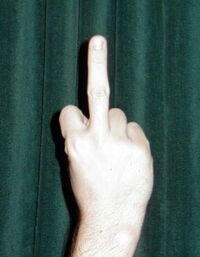
"The finger" is a very common offensive hand gesture.
"The finger" is a gesture consisting of a fist with the middle finger extended. It is culture specific and appears to be understood as "fuck you" due to its resemblance to the penis. It is certainly thousands of years old, being referred to in Ancient Roman literature as the digitus infamis or digitus impudicus. Performing this gesture is also called "flipping the bird" in countries where "the finger" is used. In other regions, "flipping the bird" refers to the raising of the middle and index finger with the back of the hand directed at the recipient.
Money sign[]
The thumb rubs repeatedly over the tip of the index finger and middle fingers. In some variants, the ring finger and pinky touch the palm, in others they do not. This gesture is meant to resemble the act of rubbing two coins together and has a general meaning of "money", or "expensive".
Moutza (Palm of hand)[]
- Main article: Moutza
In most places, a palm raised towards somebody means "stop". In urban culture, to show boredom or crude disinterest, a raised palm is held directly in front of someone's face to silence him. This is known as "tell it to the hand" or "talk to the hand."
In Greece, "moutza" the palm of the hand thrust towards somebody with the fingers splayed is an offensive gesture equivalent to giving the finger. The gesture is known in Greek as "moutza". It originates from the Byzantine punishment of parading a chained criminal around town with his face smeared with cinder, or moutzos in Greek. An even more offensive version is achieved by using both hands to double the gesture, and smacking the palm of one hand against the back of the other, in the direction of the intended recipient. Both the one-handed and the two-handed versions of this gesture can be (and often are) combined with the term "na!", meaning "here you go!" or "there!", or "na, malaka!", meaning "there, you wanker!"
OK[]
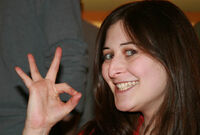
The OK sign.
- Main article: Okay
This is the touching of the index and middle finger (or just index finger) with the thumb (forming a rough circle) with the raising of the remaining fingers. In the United States and parts of Europe, it means "OK" and is inoffensive. The OK sign is used extensively in scuba diving. It can also mean "0," or "money," in Japan. In Brazil, this gesture is considered to be a reference to the anus, being considered very offensive.
In rescue operations and related use, the 'okay' signal is made by placing one hand atop one's own head, thus forming a larger "O". This gesture can be discerned more readily from a distance or under conditions of lessened visibility.
Patience[]
Palm up, index and middle fingers touching the thumb, remaining fingers folded against the palm, and wrist bending slightly, up and down about three times, so that the touching fingers move toward and away from the gesturer. This gesture is used as a reproachful and exasperated request for patience in response to a request to be served immediately out of turn or for something to happen faster than is possible.
Pointing[]
The typical pointing with the index finger is a gesture used in many cultures. Some cultures use the middle finger (certain regions of India) other cultures also point with the thumb, often when referring to something behind the speaker. There are many other ways to point, for example with the hand, a head nod or an eye gaze. In some Native American cultures, one actually points with the nose, avoiding the disrespect associated with pointing fingers. Some cultures use lip pointing. In Western cultures pointing directly with the index finger at a person is considered rude. A more polite way of pointing to a person would be to direct the hand in their direction, as if holding a plate.
Pound fist[]
Pound fist is a greeting, in which two individuals touch fists. Referred to by the Adult Swim cartoon Sealab 2021 as Respek (from "respect") Knuckles. It is also known as a Dap greeting. Howie Mandel greets contestants on Deal or No Deal in this manner due to his mysophobia.
In Major League Baseball, players will sometimes pound fists after a great play, such as hitting a home run with men on base or turning a double play.
Raising a hand[]
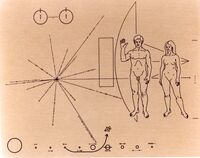
Man in Pioneer plaque raising hand to (non-verbally) say "hello".
Raising a hand is a gesture that conveys hello.[1] This gesture is close to salute.
Salute[]
- Main article: Salute
There are many forms of salute gestures, most of which are used to denote respect or obedience for an authority. A common military hand salute consists of raising the right hand, held flat, to the right eyebrow. Scouting organizations use related salutes. The armies of various countries adopt slightly different forms of salute: in the United Kingdom armed forces, the hand is brought to the forehead palm outward in military and air force contexts, whereas the naval salute is as in the US forces - the US forces derived their saluting habits from the Royal Navy.
Shaka[]
- Main article: Shaka sign
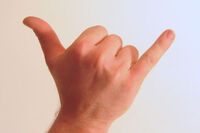
The "shaka" sign is a common greeting in beach and surfer culture.
The "shaka" sign is a common gesture often associated with Hawaii, California, and beach and surfer culture in general. It consists of extending the thumb and pinky finger while keeping the three middle fingers curled, and is often described colloquially as the "hang loose" gesture. It is similar to American Sign Language letter "Y", where a fist is also made with only the thumb and pinky extended. The sign is often followed by waving as a greeting or acknowledgement. It can be used when driving as a signal of thanks to other drivers (for example, someone who stopped to let another driver onto the road from a driveway).
Similar gestures[]

A variant of the "shaka" sign is the "call me," which mimes someone using a phone.
In Britain and Northern Europe the symbol is used as a signal for owners of older model Volkswagen vans when passing on roads. The silhouette of the hand reveals a "W"-shaped outline along the top of the hand standing for Volkswagen. The shaka is also used by the University of Texas at El Paso or UTEP to represent a pickaxe being swung forward.
In Spain and Italy, if the thumb points to the mouth, it means "drinking", since it is similar the shape of a porrón vessel. This is also true of the United States and Portugal.
In some countries, if the thumb points to the mouth, it can also represent marijuana usage, in particular the use of a bong. This is usually accompanied by a sucking noise.
In China, it is also the sign for the number six.
A similar gesture is the "call me" sign, which also has the pinky finger and thumb outstretched, but then also holds it up to the ear, to signify a telephone. This gesture is a common way to silently tell someone to call him or her, such as to continue a conversation in private.
It is also used by FC Barcelona player Ronaldinho as part of his goal celebration.
In India, rolling the shaka in a winding motion signifies that the listener does not believe what is being said and that the speaker needs to "spool in the yarn from spinning out too far".
Thanks[]
This gesture expresses gratitude. It is performed by sweeping an open hand from near one's brow toward the person being addressed, starting with the palm towards the face and finishing with the palm upwards.
Gestures similar to this one have come to be the word for 'thank you' in several Sign Languages.
Three middle fingers[]
Gestures consisting of fully extending the index, middle, and ring fingers with the thumb and pinky tucked together under the palm have had a variety of meanings over the years.
The gesture was also used by Bosnian Serbs as a victory sign, representing the Christian Trinity, during the Bosnian War. With the palm facing outwards, the fingers closed (without gaps), the right hand's fingertips to the same-side temple, it is used by the Boy scouts as their identifying salute.
In the United States, when the back of the hand faces outwards, this gesture is often used as a euphemism for "the finger." It is used especially when a jocular effect is desired. Originally, an accompanying verbal explanation was usual — "Read between the lines," referring to the common English expression denoting that one must read carefully to glean the subtle meaning in a passage — but this phrase is now commonly omitted. In the science fiction television series Farscape, the protagonist John Crichton often makes this gesture, but says "Read the middle finger." Another variant, attested in The Candidate, is that it means "peace and up yours," combining the peace sign and the finger.
Thumbing the nose[]
A sign of derision made by putting your thumb on your nose and wiggling your fingers. Originated in the 1640s in Vienna. Gained popularity when Shakespeare is said to have 'thumbed his nose' at Edmond Rostand.
Thumbs up, thumbs down[]

The thumbs down gesture.
A closed fist held with the thumb extended upward or downward is a gesture of approval or disapproval respectively. The "thumbs up" gesture may also be given as a sign of encouragement, sometimes with both hands to reinforce it.
These gestures have become metaphors in English: "My boss gave my proposal the thumbs-up" means that the boss approved the proposal, regardless of whether the gesture was made — indeed, the gesture itself is unlikely in a business setting.
The source of the gesture is obscure. Though a favorite of Hollywood 'swords and sandals' epics, where the "thumbs down" symbol means that the loser in a gladiatorial combat should be put to death, recent research suggests the meanings of the symbols have changed over the years. In 1997, Professor Anthony Philip Corbeill of the University of Kansas concluded that the thumbs up actually meant "Kill him," basing his assertion on a study of hundreds of ancient artworks. Thus, the "thumbs up" was an approval of the gladiator's request to kill his vanquished foe rather than a vote to allow the defeated to remain alive. Corbeill wrote that a closed fist with a wraparound thumb was the indication for a gladiator's life to be spared.
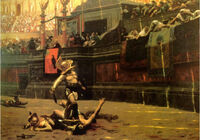
Pollice Verso by Jean-Léon Gérôme, 1872 is the immediate source of the "thumbs down" gesture in popular culture.
In Latin, the "thumbs up" gesture is called pollice recto, "thumbs down" is pollice verso. It is not certain that the contemporary gestures are identical to the gestures performed in ancient Rome. The current version was popularized by a widely reproduced academic painting by the 19th century artist Jean-Léon Gérôme, whose Pollice Verso depicts a triumphant gladiator standing over a fallen foe, looking up into the bleachers for the verdict of the crowd.
Additionally, Desmond Morris' Gestures: Their Origins and Distribution traces the practice back to a medieval custom used to seal business transactions... Over time, the mere sight of an upraised thumb came to symbolize harmony and kind feelings... The gesture's popularization in America is generally attributed to the practices of World War II pilots, who used the thumbs up to communicate with ground crews prior to take-off. American GIs are reputed to have picked up on the thumb and spread it throughout Europe as they marched toward Berlin." [3]
More recently, these gestures are associated with movie reviews, having been popularized by Gene Siskel and Roger Ebert in their televised reviews — the thumb up meaning a positive opinion of a film; the thumb down meaning a negative one. One or two thumbs up, often held over the head, may also be used by athletes in celebration of a victory.
"'Thumbs up' traditionally translates as the foulest of Middle-Eastern gesticular insults — the most straightforward interpretation is 'Up yours, pal!' The sign has a similarly pejorative meaning in parts of West Africa, South America, Russia, Iran, Greece, and Sardinia, according to Roger E. Axtell's book Gestures: The Do's and Taboos of Body Language Around the World." [4]
Hitchhikers traditionally use a thumbs up gesture to solicit rides from oncoming vehicles, although in this presentation the arm is generally outstretched with the palm and closed fingers facing the motorist.
Thumbs up and thumbs down are extensively used in scuba diving as commands to ascend or descend.
In Japan, one thumb up refers to a male lover.
Tsk-tsk[]
Palm towards the recipient, all fingers closed except for the index, which alternates from left to right, like a metronome. In English-speaking countries it has a disapproving meaning and can be accompanied by a "tsk-tsk" sound.
In Brazil, Italy, Portugal and Spain it simply means "no", and does not have any patronizing connotation, which is denoted waving the index back and forth.
V sign[]

Richard Nixon gives the V-sign one last time after resigning from the presidency.
- Main article: V sign
The "V Sign", commonly known as "sticking two fingers up" or "flicking the V's," is thought to have originated in the United Kingdom. It involves facing the palm inwards, while the index and middle fingers are extended vertically. This is the way that Winston Churchill initially indicated "Victory," at the beginning of the Second World War (often with a large cigar jammed between the two fingers), but he reversed the sign later in order to distinguish the "V for Victory" campaign from a gesture widely considered insulting.
Popular legend holds that the sign originated with British archers in the Hundred Years War (1337 -1453). According to the legend, it was the habit of French captors to cut off the fingers of British archers when captured, thus disabling their ability to fire. It is said that mass salute evolved at the beginning of battles, showing the opposing French soldiers that they were still capable of effecting the massive damage associated with the war bow. There is, however, no record of this practice in any contemporary source, and the story must be regarded as a myth.
The palm outward sign was used in the Vietnam war era to mean "peace" and was famously used by American President Richard Nixon. It has now been claimed by hip-hop culture as a salute, held palm inwards, horizontally, often accompanied by the words "peace" or "peace out"
The palm out version is common in Anime, and has permeated popular Asian culture. Japanese people, usually female teenagers, are commonly seen placing the "V" next to the face during photographs.
It is also the sign for the letter V in American Sign Language.
Wanker[]
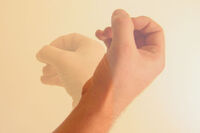
Wanker
A loose fist (with all fingers forming a cylindrical shape) is made, and shaken up and down (or sometimes, back and forth) at the wrist.
The gesture is imitative of the motions of male masturbation. Its meaning is equivalent to the word wanker or implies something is of little importance. If directed to a person or group, who are not necessarily present, it is considered a display of contempt toward them.
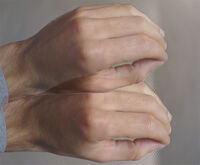
The Overhand Portuguese Wanker Gesture
In Greece and Portugal the wanker gesture is used with the palm facing the ground thereby implying that the person is masturbating someone else rather than themselves. As such this has homosexual or promiscuous implications when directed at someone instead of the milder suggestion that they enjoy self-gratification.
Waving[]
Hand waving is a gesture in which the hand is raised and moved back and forth, as a greeting, a sign of departure, or call for attention. The orientation of the hand varies by culture and situation. In many cultures, the palm is oriented toward the recipient of the wave.
In Chinese culture, people move the hand left and right as a greeting, while orienting the hand palm-down and waving it up and down signifies "come here", rather than a greeting.
Whatever McDonalds Worker[]
In America, a gesture where the index, middle, and ring fingers are held up, palm out, to represent a W, then turned down to represent an M, then back to W, is a gesture used to dismiss a statement as being irrelevant, due to the low status of the speaker[2]
Using two hands[]
Air quotes[]
- Main article: Air quotes
This phrase refers to using one's fingers to make virtual quotation marks in the air when speaking.
"Gills"[]
This gesture involves holding the backs of the wrists against the jawline (with elbows outstretched) and then waggling one's fingers. The gesture is often accompanied by a feminine-voiced "Ooooo!" which rises and falls in intonation. It is used when one would normally say (sarcastically) "well aren't you clever?", or to imply that someone is acting too posh for their station. It is peculiar to Scotland owing to its use in Scottish TV show Chewin the Fat.
Scream[]
The palms are against the sides of the face, eyes wide and mouth open round. This gesture is depicted in Edvard Munch's The Scream. To imitate the painting, there may be a small space between the palms and the face. It is used to express great horror. With the mouth closed, it is used to express dismay. A similar gesture, placing the hands against the front of the face, little fingers parallel and touching, can express sadness, remorse, or speechlessness over any bad event.
"Shame on you"[]
This gesture involves pointing at a person with the index finger of one hand while rubbing the pointed finger with the index finger of the opposite hand. The rubbing motion is directed toward the intended recipient and is repeated at least three times. It is used to imply that the targeted person should feel shame.
Time-out[]
The "time-out" gesture — a "T" formed with the hands, with one hand with flat palm placed perpendicular to the other hand with flat palm, roughly in the center — originates in American sports. It is used by players to signal for a time out, or brief pause in play. In basketball, the gesture is additionally used by referees to indicate that a player or coach is guilty of a technical foul.
In Portugal this gesture is used to say "Please give me some time" (or some more time).
Tea?[]
Similar to the "time-out" gesture, here the vertical bar of the "T" is formed with the index finger of the opposite hand instead of the whole hand. It is used, primarily in Britain, to silently offer the recipient a cup of tea.
Whatever McDonalds Worker[]
A two-handed version of "Whatever, McDonald's Worker" is made by placing the ends of the thumbs together at a 90 degree angle, and pointing up with both index fingers to form the shape of a "W", then rotating this forward ("M") and back again ("W").
X-Factor[]
The X-Factor is a guesture used by many athletes (usually pro) as a way of "showing off" or gloating. It is done by crossing your arms so they form an "X" and raising them slightly above eye level. (this same guesture is seen in the game NFL Street and 2). In Japan and Hawaii, it is a signal to busdrivers that you are not taking their bus.
See also[]
Salute
References[]
- ↑ Cooke, Jean. (Jul., 1959). A Few Gestures Encountered in a Virtually Gestureless Society. Western Folklore Vol. 18, No. 3, pp. 233-237. doi:10.2307/1497708.
- ↑ [1] The Urban Dictionary: Whatever McDonald's Worker
- Bulwer, John (1644). "Chirologia: or the Naturall Language of the Hand" (London,1644)
- Goldin-Meadow, Susan (2003). The resilience of language: What gesture creation in deaf children can tell us about how all children learn language. In the Essays in Developmental Psychologyseries (J. Werker & H. Wellman, Eds.). New York: Psychology Press.
- Goldin-Meadow, Susan (2003). Hearing gesture: How our hands help us think. Cambridge, MA: Harvard University Press.
- Johns, C. (1982). Sex or Symbol. Erotic Images of Greece and Rome. London: British Museum Publications.
- Kendon, Adam (ed.) (1981). Nonverbal Communication, Interaction and Gesture: Selections from Semiotica (Vol.41, Approaches to Semiotics). The Hague: Mouton and Co. [Includes as an Introduction by Kendon an extended critical survey of methodological and theoretical issues in the field].
- Kendon, Adam (1997). Annual Review of Anthropology. 26: 109-128.
- Kendon, Adam (2000). Gesture in Naples and Gesture in Classical Antiquity. An English translation, with an Introductory Essay and Notes of La mimica degli antichi investigata nel gestire Napoletano ('Gestural expression of the ancients in the light of neapolitan gesturing') by Andrea de Jorio (1832). Bloomington, Indiana: Indiana University Press.
- Kendon, Adam (2004). Gesture: Visible Action as Utterance. Cambridge: Cambridge University Press.
- McNeill, David (1992). Hand and Mind. What Gestures Reveal about Thought. Chicago: Chicago University Press.
- McNeill, David (2005). Gesture and Thought. Chicago: Chicago University Press.
- Kita, S. (ed.) (2003). Pointing: Where Language, Culture and Cognition Meet. Lawrence Erlbaum Associates, ISBN 0-8058-4014-1.
External links[]
- International Society for Gesture Studies(ISGS) is an international scholarly association devoted to the study of human gesture. The ISGS organizes conferences and supports the Journal GESTURE.
- McNeill Lab Center for Gesture and Speech Research David McNeill's Lab homepage: The Center for Gesture and Speech Research at the University of Chicago studies speech and gesture from a psycholinguistic perspective. The page provides lots of useful information about gesture analysis.
- The Goldin-Meadow Lab Susan Goldin-Meadow's Lab homepage. The lab is composed of graduate students and researchers pursuing independent topics related to cognition, development, education, linguistics, and various other fields, but interrelated by the lab's main focus - the study of non-verbal communication, specifically gestures.
- The Nijmegen Gesture Center (NGC) at the Max Planck Institute for Psycholinguistics studies the role of gestures in psycholinguistic processing, communication and interaction, acquisition, cognition, and neurocognition.
- Journal GESTURE is a scholarly Journal that publishes articles reporting original research, as well as survey and review articles, on all aspects of gesture.
- Publications by Adam Kendon (field data, research techniques and theory of gesture and sign languages)
- A Nice Gesture Many stories and anecdotes on gestures.
- A Repertoire of South African Quotable Gestures, Journal of Linguistic Anthropology.
- Handspeak Sign languages, gestures, body languages, Baby Sign, International Sign, and more. Paid site with limited content for free.
Gestures | ||
|---|---|---|
| Friendly gestures |
A-ok · Air kiss · Big up · Cheek kissing · Dap greeting · Thumbs up · Fist pound · Namaste · High five |
 |
| Formal gestures |
Bowing · Curtsey · Hand-kissing · Genuflection | |
| Salutes |
Salute · Bellamy salute · Final Salute · Hitler salute · Roman salute · Royal Salute · Scout sign and salute · Three-finger salute · Two-fingers salute | |
| Celebration gestures |
Applause · Fist pump · Gig 'em Aggies · High five · Hook 'em Horns | |
| Obscene gestures |
Bowfinger · Corna · Finger · Mooning · Shocker · Moutza | |
| Other |
Air quotes · Anasyrma · Articulatory gestures · Crossed fingers · Gang signal · Hand gesture · Head bobble · Jazz hands · Lock and fly · Manual communication · Mudra · Nod · Poke · Pollice verso · Puppy face · Raised fist · Shaka sign · Shrug · Sign of the Cross · Thai greeting · Type of gesture · Varadamudra · V sign · Vulcan salute · War Chant · | |
| List of gestures | ||
| This page uses Creative Commons Licensed content from Wikipedia (view authors). |